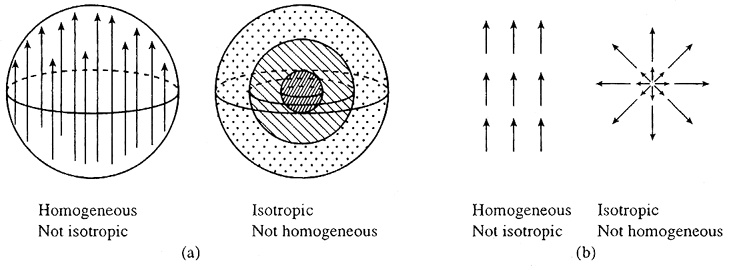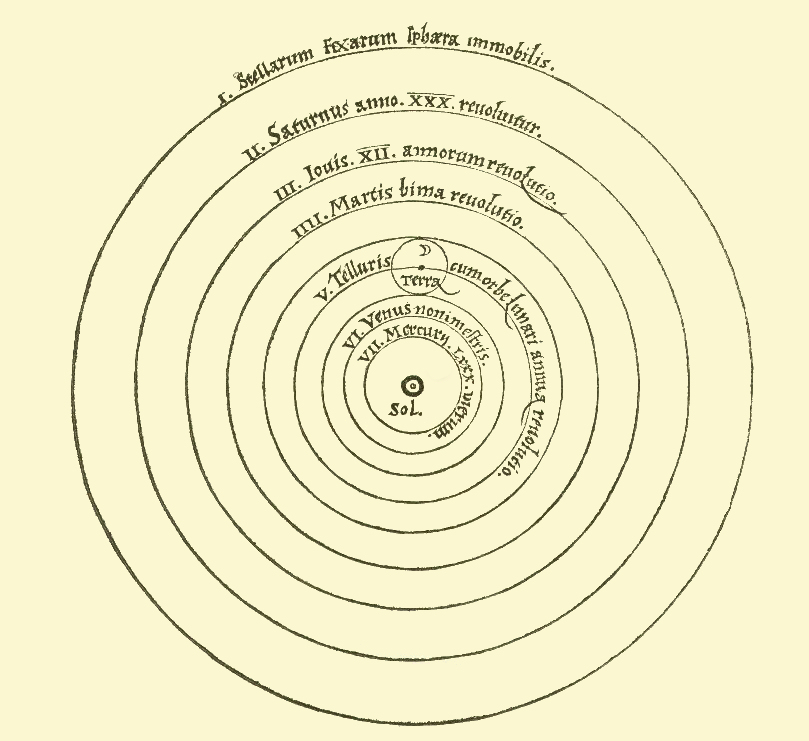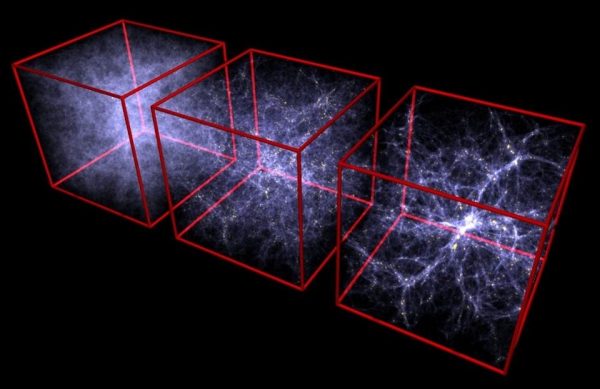Cosmologists have had to make a number of basic assumptions about the very nature of our universe. As there is only one universe, as far as we can physically know, there is nothing else we can compare it against. There is no control experiment you could do in lab that gives birth to another universe in order to test ones theories by.
The most basic of these assumptions are encapsulated in the Cosmological Principle. The Cosmological Principle, the foundational stone of mainstream cosmology, states that the distribution of matter throughout the universe is both homogenous and isotropic when viewed from a large enough scale. [1] [2]

Illustrations of how homogeneity and isotropy are not equivalent in (a) three dimensions and (b) two dimensions. In the first example of each, a unique direction is picked out but translation invariance is maintained. In the second example of each, all directions are the same (rotation invariance) but a radial gradient exists. [2]
In order to understand the depth of meaning in this statement let’s unpack it.
So what do we mean by homogenous? A homogenous system has the same properties at every point; it is uniform without irregularities. A large region of a homogenous universe looks approximately the same when compared to any other large region of the universe.
Another way to state this is to say that the same laws of physics that we experience here on Earth are the same through out the entire universe. Thus spiral galaxies all tend to look the same because the same laws of physics that made our own milky way galaxy the spiral shape it is, also by extension, is responsible for the shapes of all the other spiral galaxies.
And what do we mean by isotropic? An isotropic universe would look the same in all directions. Point a telescope one way peering into the distant universe and the picture would look very similar to another picture taken of the distant universe if the telescope was looking in another direction.
In medieval times, the assumption and belief was that the Earth was the centre of all creation. It was considered by man to be the centre of God’s creation. Copernicus overturned this belief that the Earth was not the centre of the universe when he showed that both it and all the other planets in our solar system orbit around our sun. The sun in turn holds no special place, or orientational direction, in our galaxy as compared to all the other stars in the Milky Way. [3]

Heliocentric model from Nicolaus Copernicus’ “De revolutionibus orbium coelestium” (On the Revolutions of the Heavenly Spheres).
Our place in the universe is one of complete random chance. What this means for physics is that the same experimental results we record here will be the same regardless of our location in the universe. Stars and planets in the farthest galaxies are made of the same stuff; the atoms shown on our periodic table.
In effect the cosmological principle says that look far enough out into the depth of the universe and you’ll see the same picture pattern over and over again. A picture of multiple galaxies whose count falls inside a predictable range.
Randomly select a sufficiently large enough volume of space within our universe and count the number of galaxies occupying it. Repeat this process, again randomly select a sufficiently large enough volume of space and again count the number of galaxies inside that volume.

A volume of the universe is randomly selected and we count the number of galaxies inside said volume. We repeat this process over and over again throughout the observable universe to create our dataset of galaxy count. Plotting this on a graph we should see a normal distribution plot if the universe is in fact homogenous. That is, we should find roughly the same number of galaxies inside a given volume no matter the location of the volume within the universe.
If the distribution of matter throughout the universe were homogenous and isotropic then the number of galaxies found in any sufficiently large enough volume would roughly always be the same regardless of the volume's location. Meaning, that if I continued repeating the same process of randomly selecting a sufficiently large enough volume and recording the number of galaxies inside that volume, again and again, I would expect its count to fall within a normal distribution.
The importance of the Cosmological Principle, as stated as such, is that the observations and experiments we do here on Earth would be the same elsewhere in the universe. And when we look far out into the observable universe we do see this the same distribution of galaxies from nearly all over. I say, nearly as we’ll look at a number of new discoveries that have caused some cosmologists to question this principle.
When we look out into space, from here on Earth, we look back in time. The furthest moment in time we are able to look back to is to the light emitted in the afterglow of the Big Bang event. Namely, the Cosmic Microwave Background Radiation. Anything beyond this is beyond our sight. So in order to make statements about the larger universe, beyond our vision, we need to make a number of assumptions and that is the point of this Cosmological Principle.
In the Big Bang Hypernova Hypothesis the mostly homogenous and isotropic state of the universe is accounted for as coming from the irrotational vortex in the formation of the jet. In this slow motion video where milk is mixed with tea we can see this physical process. Here the mixture of tea mixed with milk becomes a homogenous mixture because of the irrotational vortex formed from stirring the tea.
Such a statement, in light of the universe being flat, is that the universe is infinite. That it has no edge. I will argue otherwise. I mean how can it be infinite, with no edge, if the universe is finitely old, 13.6 billon years or so? Rather this appearance of isotropic and homogenous arises from the rotational vortex of the jet that is our universe. As I’ll demonstrate using a nice hot cup of tea. [4]
Another problem in this definition, that the distribution of matter is homogenous and isotropic at a sufficiently large enough scale, is the “sufficiently large enough scale”. What is sufficiently large enough? I’ve discovered an ever increasing number of definitions of “sufficiently large” while researching this piece. And in an infinite universe sufficiently large can be conveniently expanded to any size.
One definition of sufficiently large, coming from wikipedia’s page on the cosmological principle, is that it is statistically homogenous on scales larger than 250 million light years. Another interpretation, from the Sloan Digital Sky Survey, suggests that the galaxies smooth out above 100 Mega-parsecs, or 326 million light years.
A very important factor to consider when applying the cosmological principle is the evolution of galaxies in relation to each other by the force of gravity.
Flying through the hot plasma atmosphere of a galaxy cluster, revealing the richness of substructure and their dynamics during the formation of the largest gravitational bound objects in the universe. When falling into the cluster, the galaxies are losing their gaseous atmosphere (appearing in white), forming comet-like features of gas trails. Due to tidal forces these trails sometimes get deformed into arc-like structures. [5]
It has been discovered that galaxies, under the influence of gravity, clump together. These clumps form groups. In turn groups of galaxies come together to form clusters. And lastly, that these clusters of galaxies group together into superclusters. This clustering of galaxies evolves over time. [5]
Meaning, that galaxies whose initial distribution was homogenous and isotropic in the very early universe came together to form clusters and then superclusters over time. Looking out at those galaxies closest to us we should see the formations of clusters and superclusters. But for those galaxies in the very early universe, at the limit of our vision, then we shouldn’t see this. Rather the distribution should be homogenous in the pictures of the far distant and early universe.
With all that said, what makes me think that these assumptions are in fact false? The Cosmic Microwave Background Radiation after all was found mostly to be mostly isotropic and homogenous with little variation reenforcing the belief in the standing Cosmological Principle.

Illustration showing snapshots from a simulation by astrophysicist Volker Springel of the Max Planck Institute in Germany. It represents the growth of cosmic structure (galaxies and voids) when the universe was 0.9 billion, 3.2 billion and 13.7 billion years old (now). Image via Volker Springel/ MPE/ Kavli Foundation. [6]
Well this last statement about the microwave background in regards to be isotropic is strictly not true. Collectively known as the Axis of Evil a series of very improbable alignments to Earth and our solar system were seen in the Cosmic Microwave Background Radiation. For instance, the CMB is slightly cooler when viewed through the “top half” of our solar system, and slightly warmer on the opposite side. It’s not much of a variation, just a handful of microKelvin difference, but its measurable and definitely there.

At the very largest scale of the entire universe rotation plays a critical role which is illustrated in the two quadrupole maps. The map on the left shows the quadrupole map of the Cosmic Microwave Sky as taken from WMAP. The map on the right is the quadrupole map showing the statistical significance of preferred direction of rotation (either clockwise or anticlockwise) of galaxies. [7] [8] [9]
Initially written of as a statistical fluke when it was first observed in the WMAP experiment the same observation was made again in the Planck mission. Two independent experiments recorded the same result passing a major hallmark of scientific discovery, independent reproduction of the same unexpected result. [7] [10]
Although we shall look at this series of anomalies, known as the Axis of Evil, in much greater depth later on it is a result that flies directly in the face of the assumption that the universe is isotropic. That is, both the Earth and the solar system have this improbable alignment to various anisotropies identified in the CMB and this result has been reproduced in two independent experiments.
I do not believe this improbable alignment is some mere random fluke of nature. Rather it is a property of nature whose invisible underlying framework we shall endeavour to explore.
References:
- [1] Lectures on Cosmology - Pedro G. Ferreira, Astrophysics, University of Oxford
- [2] Cosmological Principle Lecture - University of Oregon
- [3] Ancient Cosmology Lecture - University of Oregon
- [4] A Flat Universe from High-Resolution Maps of the Cosmic Microwave Background Radiation : P. de Bernardis, P.A.R.Ade, J.J.Bock, J.R.Bond, J.Borrill, A.Boscaleri, K.Coble, B.P.Crill, G.De Gasperis, P.C.Farese, P.G.Ferreira11, K.Ganga, M.Giacometti, E.Hivon, V.V.Hristov, A.Iacoangeli, A.H.Jaffe, A.E.Lange, L.Martinis, S.Masi1, P.Mason, P.D.Mauskopf, A.Melchiorri, L.Miglio, T.Montroy, C.B.Netterfield, E.Pascale, F.Piacentini, D.Pogosyan, S.Prunet, S.Rao, G.Romeo, J.E.Ruhl, F.Scaramuzzi, D.Sforna, N.Vittorio
- [5] Galaxy Formation, Data Visualization - Max-Planck Institute
- [6] What is dark energy? - Andy Briggs
- [7] The significance of the largest scale CMB fluctuations in WMAP - Angelica de Oliveira-Costa, Max Tegmark, Matias Zaldarriaga & Andrew Hamilton
- [8] On the large-angle anomalies of the microwave sky - Craig J. Copi, Dragan Huterer, Dominik J. Schwarz and Glenn D. Starkman
- [9] Multipole alignment in the large-scale distribution of spin direction of spiral galaxies - Lior Shamir
- [10] Planck 2013 results. XXIII. Isotropy and statistics of the CMB (5. Intriguing inconsistencies – WMAP anomalies revisited.) - Planck Collaboration